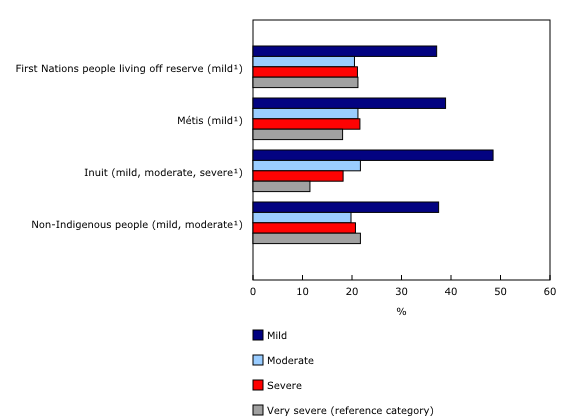Indigenous people with disabilities in Canada: First Nations people living off reserve, Métis and Inuit aged 15 and older
Archived Content
Information identified as archived is provided for reference, research or recordkeeping purposes. It is not subject to the Government of Canada Web Standards and has not been altered or updated since it was archived. Please "contact us" to request a format other than those available.
Released: 2019-12-12
In 2017, 32% of First Nations people living off reserve, 30% of Métis and 19% of Inuit had one or more disabilities that limited them in their daily activities.
The new study "Indigenous people with disabilities in Canada: First Nations people living off reserve, Métis and Inuit aged 15 years and older," released today, is based on data from the 2017 Aboriginal Peoples Survey.
The study uses Canada's new disability screening questions to measure disability. It defines persons with disabilities as individuals who experience limitations in their everyday activities as a result of a long-term condition or health-related problem. This approach focuses on social participation and the interaction of an individual's functional limitations and barriers in the environment.
Disability increases with age for both men and women among all three Indigenous groups
Disability prevalence tends to increase with age for the overall population, and Indigenous people tend to be younger than the non-Indigenous population. Inuit were the youngest of the three Indigenous groups, with an average age of 28 years, followed by First Nations people, at 31 years, and Métis, at 35. The average age of the non-Indigenous population was 41 years.
Disability increased with age among First Nations people living off reserve, Métis and Inuit. Among all three Indigenous groups, disability rates among men and women aged 40 and older were higher than those of people aged 15 to 24. Exceptions to this were found among Métis women and Inuit men, where an increase in disability was observed among those aged 55 years and older.
Among those with disabilities, 4 in 10 First Nations people living off reserve and Métis, and 1 in 3 Inuit, have a severe or very severe disability
Four disability severity classes were established: mild, moderate, severe and very severe. Among all groups, the most prevalent level of disability severity was mild. About half of Inuit (49%) and over one-third of Métis (39%) and First Nations people living off reserve (37%) with disabilities had a mild disability. These rates were similar for women and men. Among those with disabilities, 42% of First Nations people living off reserve, 40% of Métis and 30% of Inuit had a severe or very severe disability. In all cases, the disability was severe enough to cause limitations in their daily lives.
Pain-related disabilities are the most common disability type among all Indigenous groups
About 1 in 5 First Nations people living off reserve and Métis had a pain-related disability, whereas just over 1 in 10 Inuit had this disability type. Mental health-related disabilities were the second most common type among all three Indigenous groups, with 14% of First Nations people living off reserve and 13% of Métis having this type of disability. Among Inuit, the proportion was 6%.
Note to readers
Findings from the study should be interpreted while keeping in mind the unique characteristics and experiences of Indigenous peoples. These characteristics and experiences include a younger population, unique geographical distribution, and limited access to supports and services such as health care, in addition to the historical and ongoing impacts of colonization.
This study is based on data from the 2017 Aboriginal Peoples Survey (APS), a unique national survey designed to collect information on the social and economic conditions of Indigenous peoples in Canada. It uses the disability screening questions, added to the APS for the first time in 2017. Findings from the study will help set the stage for further analysis on Indigenous people with disabilities.
The APS is a national survey of the Indigenous identity population aged 15 and older living in private dwellings, excluding people living on Indian reserves and settlements and in certain First Nations communities in Yukon and the Northwest Territories. The data presented represent single Indigenous identity responses. The APS response rate was 76%, yielding a sample of approximately 24,000 Indigenous respondents.
Products
The article "Indigenous people with disabilities in Canada: First Nations people living off reserve, Métis and Inuit aged 15 years and older" is now available as part of the publication Aboriginal Peoples Survey (89-653-X).
Contact information
For more information, or to enquire about the concepts, methods or data quality of this release, contact us (toll-free 1-800-263-1136; 514-283-8300; STATCAN.infostats-infostats.STATCAN@canada.ca) or Media Relations (613-951-4636; STATCAN.mediahotline-ligneinfomedias.STATCAN@canada.ca).
- Date modified:


